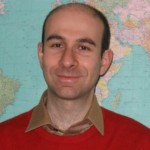Polterovich, Iosif

- Full Professor
-
Faculty of Arts and Science - Department of Mathematics and Statistics
André-Aisenstadt Office 5229
Courriels
Affiliations
- Membre Centre de recherches mathématiques
- Membre CRM Centre de recherches mathématiques
Research area
Student supervision Expand all Collapse all
Abstract
Abstract
Abstract
Abstract
Abstract
Abstract
Abstract
Abstract
Abstract
Abstract
Abstract
Abstract
Abstract
Abstract
Abstract
Abstract
Abstract
Abstract
Abstract
Research projects Expand all Collapse all
Centre de recherches mathématiques (CRM) FRQNT/Fonds de recherche du Québec - Nature et technologies (FQRNT) / 2022 - 2029
Supplément COVID-19 CRSNG_Spectral geometry and topology and their applications CRSNG/Conseil de recherches en sciences naturelles et génie du Canada (CRSNG) / 2020 - 2021
Spectral geometry and topology and their applications CRSNG/Conseil de recherches en sciences naturelles et génie du Canada (CRSNG) / 2017 - 2024
Spectral geometry and topology and their applications CRSNG/Conseil de recherches en sciences naturelles et génie du Canada (CRSNG) / 2017 - 2023
CENTRE DE RECHERCHES MATHEMATIQUES (CRM) FRQNT/Fonds de recherche du Québec - Nature et technologies (FQRNT) / 2015 - 2023
Fonctions propres et asymptotiques spectrales FRQNT/Fonds de recherche du Québec - Nature et technologies (FQRNT) / 2015 - 2019
THE CRM : 50 YEARS OF SHAPING MATHEMATICAL SCIENCES IN CANADA CRSNG/Conseil de recherches en sciences naturelles et génie du Canada (CRSNG) / 2014 - 2023
THE CRM : 50 YEARS OF SHAPING MATHEMATICAL SCIENCES IN CANADA CRSNG/Conseil de recherches en sciences naturelles et génie du Canada (CRSNG) / 2014 - 2022
CHAIRE DE RECHERCHE DU CANADA - GEOMETRIE ET THEORIE SPECTRALE SPIIE/Secrétariat des programmes interorganismes à lintention des établissements / 2014 - 2019
COMPUTATIONAL RESOURCES FOR RESEARCH IN MATHEMATICS AND STATISTICS CRSNG/Conseil de recherches en sciences naturelles et génie du Canada (CRSNG) / 2013 - 2015
TOPICS IN GEOMETRIC SPECTRAL THEORY CRSNG/Conseil de recherches en sciences naturelles et génie du Canada (CRSNG) / 2012 - 2018
ANALYSE GEOMETRIQUE AND SPECTRAL FRQNT/Fonds de recherche du Québec - Nature et technologies (FQRNT) / 2012 - 2016
CHAIRE DE RECHERCHE DU CANADA EN GÉOMÉTRIE ET THÉORIE SPECTRALE SPIIE/Secrétariat des programmes interorganismes à lintention des établissements / 2009 - 2014
CENTRE DE RECHERCHES MATHEMATIQUES (CRM) FRQNT/Fonds de recherche du Québec - Nature et technologies (FQRNT) / 2008 - 2016
Selected publications Expand all Collapse all
The legacy of Vladimir Andreevich Steklov
Inverse electrostatic and elasticity problems for checkered distributions
Upper bounds for Steklov eigenvalues on surfaces
On the Hersch-Payne-Schiffer estimates for the eigenvalues of the Steklov problem
Shape optimization for low Neumann and Steklov eigenvalues
Maximization of the second positive Neumann eigenvalue for planar domains
Average growth of the spectral function on a Riemannian manifold
Pleijel's nodal domain theorem for free membranes
A lower bound for the remainder in Weyl's law on negatively curved surfaces
Estimates from below for the spectral function and for the remainder in local Weyl's law
Extremal metric for the first eigenvalue on a Klein bottle
Isospectral domains with mixed boundary conditions
Spectral problems with mixed Dirichlet-Neumann boundary conditions: isospectrality and beyond
How large can the first eigenvalue be on a surface of genus two?
Lower bounds for the spectral function and for the remainder in local Weyl's law on manifolds
Regularized traces and Taylor expansions for the heat semigroup
Combinatorics of the heat trace on spheres
Explicit constructions of universal $\Bbb R$-trees and asymptotic geometry of hyperbolic spaces
A commutator method for computation of heat invariants
Heat invariants of Riemannian manifolds
From Agmon-Kannai expansion to Korteweg-de Vries hierarchy
Structures at infinity of hyperbolic spaces
An asymptotic subcone of the Lobachevski plane as afunction space
On a characterization of flat metrics on $2$-torus
